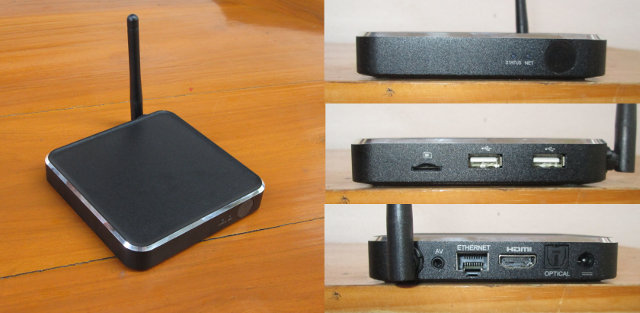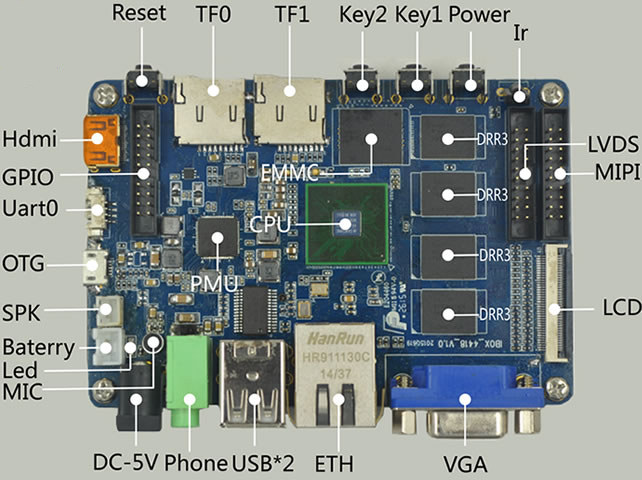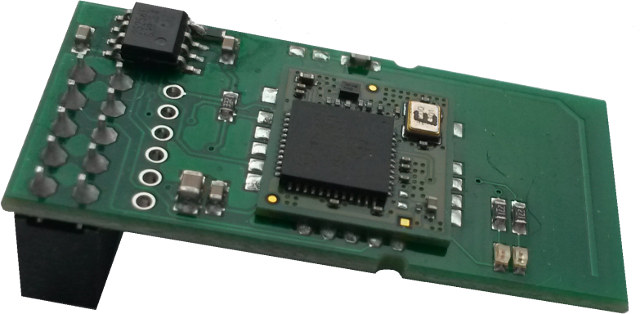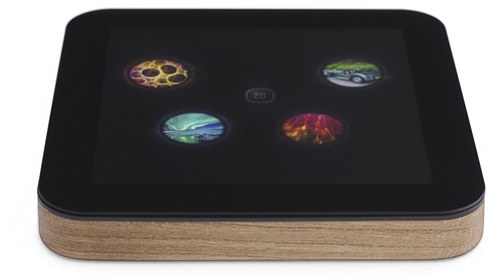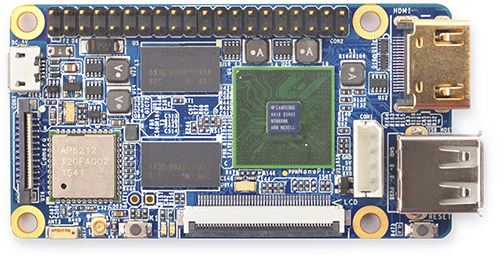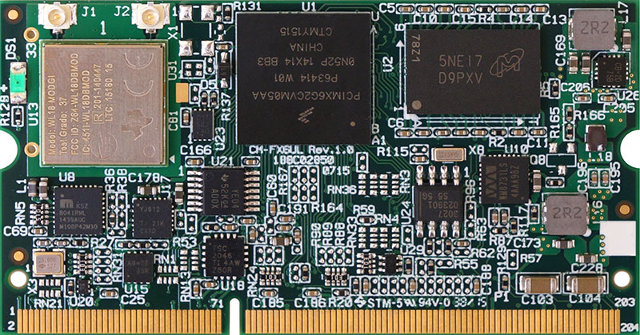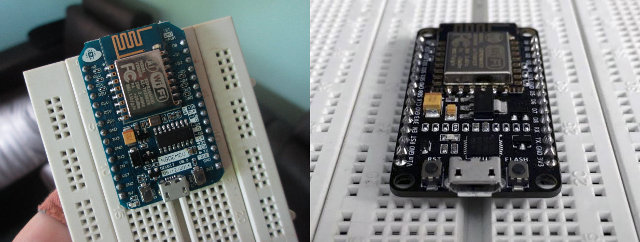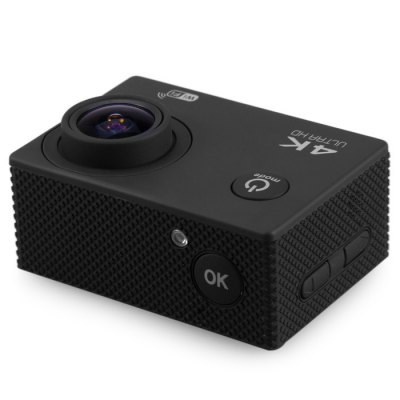The second device for this giveaway week is ARNU Box Mach Q TV box that runs Kodi 15.2 on an Amlogic S805 quad core processor with 1GB RAM and 8GB flash, the little brother of ARNU Box Mach 10 powered by the more powerful Amlogic S812 processor. Due to lack of time I did not review ARNU Box Mach Q, but I did review ARNU Box Mach 10, which is loaded with a similar firmware based on Linux based EmBER OS. Video playback was very good with Kodi 15.2 with automatic frame rate switching support, working audio pass-through via S/PDIF, but HDMI audio pass-through did not work with my AV receiver. Since it’s the same firmware base, I fully expect the same good video experience on ARNU Box Mach Q minus support for 4K videos. You can find more pictures on ARNU Box Mach Q unboxing and teardown post. To […]
Graperain G6818 IBOX Board is Powered by Samsung S5P6818 Octa-core Cortex A53 Processor
Shortly after writing about NanoPi2 development board based on Samsung S5P4418 processor, I checked some other more featured solutions based on the same processor, but made by competitors such as Graperain G4418 IBOX Card Computer or ARMBest Core4418 module. Whiel browsing Shenzhen Graperain Technology website, I discovered another processor by Samsung with S5P6818 octa core Cortex A53 processor found in their G6818 IBOX single board computer. Board specifications: SoC – Samsung S5P6818 octa-core ARM Cortex A53 processor @ 1.4 to 1.6 GHz with Mali-400MP 3D GPU System Memory – 2GB DDR3 up to 800MHz (1GB optional) Storage – 8GB eMMC Flash (16GB optional) + 2x micro SD slot Video Output / Display I/F – micro HDMI and VGA connectors; LCD (RGB), MIPI DSI and LVDS interfaces; Audio – micro HDMI, headphone jack, speaker header; Connectivity – Gigabit Ethernet (RTL8211E), Wifi and Bluetooth 4.0 (Realtek RTL8723BU module) USB – 2x USB 2.0 […]
Razberry Board and UZB Dongle Add Z-Wave (Plus) to Raspberry Pi Boards
Z-Wave is one of the low power wireless communication protocols used for automation, and supported, for example, by gateways such as Samsung SmartThings Hub or Vera3. Z-Wave Plus is a certification program used to identify Z-wave 5th Generation hardware platform, allowing a greater range up to 45 meters, 50% improvement in battery life, 250% more bandwidth, and providing a standardized method for Over the Air firmware updates (OTA), among other things. Zwave.me, a startup registered in Switzerland, is specializing in Z-Wave products and solutions, and among their other products they’ve also designed Z-Wave hardware to turn the Raspberry Pi board and other compatible hardware into a Z-Wave gateway. RazBerry module will fit into the 26 or 40-pin header found on Raspberry Pi boards, and comes with the following specifications: Sigma Designs ZM5202 Z-Wave transceiver module Frequencies – Storage – 32KB SPI flash for network data CPU/MCU Interface – UART (Tx/Rx) […]
Solu Touch-Enabled Portable mini PC Runs a Cloud-linked OS on Nvidia Tegra K1 (Crowdfunding)
Solu Machines, has startup based in Finland, as decided to re-invent the computing experience. To achieve this they’ve created a battery powered mini PC based on Nvidia Tegra K1 processor and 4GB RAM, included a touch screen on the top cover that can be used as a tablet on the go, and as a touchpad when connected to a monitor, while creating a new OS called SoluOS with a new type of user interface and that stores lots of the data in the cloud, yet allows the device to run offline, and there’s more… Solu mini PC specifications: SoC – Nvidia Tegra K1 4-Plus-1 ARM Cortex-A15 CPU @ 2.3GHz with 192-core Kepler GPU System Memory – 4GB LPDDR3 Storage – 32GB “cache capacity” Display – 1440 x 1440, 450ppi, with an edge-to-edge touch Video Output – Support for up to 4K monitors apparently via USB type-C connector Connectivity – Dual-band […]
NanoPi2 is a Tiny Board with Samsung S5P4418 Processor, WiFi and Bluetooth Connectivity
FriendlyARM released NanoPi board this summer, a small and inexpensive development board based on Samsung S3C2451 ARM9 processor with both WiFi and Bluetooth connectivity. The company has now unveils a more powerful, and slightly wider, version with NanoPi2 featuring Samsung S5P4418 quad core Cortex A9 processor with 1GB RAM, AP6212 wireless module, a new HDMI output, and the same connectors for I/Os and LCD displays. NanoPi2 specifications: SoC – Samsung S5P4418 quad core Cortex A9 processor @ up to 1.4GHz System Memory – 1GB 32bit DDR3 Storage – 2 x Micro SD Slot Connectivity – 802.11 b/g/n WiFi and Bluetooth LE 4.0 via AP6212 module Video Output / Display I/F- 1x HDMI 1.4a, 0.5 mm pitch SMT FPC seat for type-A full-color LCD (RGB: 8-8-8) Camera – 24-pin DVP interface USB – 1x USB Host port; 1x micro USB 2.0 OTG port for power and data Expansions Headers – 40-pin […]
Compulab Unveils CL-SOM-iMX6UL Freescale i.MX 6UltraLite System-On-Module and SBC-iMX6UL SBC
Compulab has launched a CL-SOM-iMX6UL system-on-module based on Freescale i.MX 6UltraLite ARM Cortex A7 processor with up to 1GB DDR3 and 32GB eMMC flash. The module can be coupled with SB-SOM-iMX6UL carrier board to form SBC-iMX6UL single board computer targeting industrial and embedded applications. CL-SOM-iMX6UL specifications: SoC – Freescale i.MX6 UltraLite Cortex-A7 processor @ 528MHz System Memory – Up to 1GB DDR3 Storage – Up to 32GB on-board eMMC, Up to 1GB on-board SLC NAND, SPI flash, I2C EEPROM Connectivity – Dual-band, dual-antenna 2×2 802.11a/b/g/n WiFi, Bluetooth 4.1 BLE (Ti WiLink 8), 10/100M Ethernet PHY (with optional bypass) Audio – WM8731 audio codec with stereo line-out, line-in, mic, S/PDIF input/output Other I/Os via 204-pin SODIMM edge connector Display Parallel 24-bit display interface up to 1366 x 768 Touchscreen 4/5/8-wire resistive touch-screen support Capacitive touch-screen support through SPI interface USB – 1x USB2.0 OTG + 4x USB2.0 host ports Up to […]
Getting Started with NodeMCU Board Powered by ESP8266 WiSoC
Since ESP8266 is now so popular, I’ve recently bought a NodeMCU board to try it. I selected this board because the latest version of the board is breadboard-friendly, integrates a USB to serial chip, and it can be powered by a simple USB to micro USB cable. I also noticed a ESP8266 tutorial with NodeMCU firmware by SwitchDoc Labs the other day (using ESP-12 and Adafruit Huzzah), which I applied to my NodeMCU board, but since I encountered a few issues, I decided to report my findings, and write my own little getting started guide to switch on/off LED and GPIOs using a web interface. NodeMCU v0.9 and NodeMCU v1.0 If you are going to purchase a NodeMCU board it’s important to know there are two official versions: NodeMCU v0.9 with ESP-12 module NodeMCU v1.0 with ESP-12E module The main complain about NodeMCU v0.9 is that while it fits on […]
$64 Allwinner V3 Action Cameras Support 4K Video Recording (or Not?)
An “Allwinner V3 4K Ultra HD DV Sport Camera” just appeared in GeekBuying product feed which the company sells for $84.39, and searching for alternative sellers led me to Soocoo F60 4K action camera sold for $63.34 on GearBest. Both cameras look the same, and the price appears amazing cheap as 4K cameras such as GoPro Hero4 or Sony X1000V normally sell for $500 and more. But one of the tricks is that both “4K” cameras are likely based on Sunchip 4K camera design, which does support 4K video recording, but only at 15 fps. Soocoo F60 camera specifications: SoC – Allwinner V3 ARM Cortex A7 processor @ 1.2GHz System Memory – N/A Storage – micro SD card up to 64GB Display – 2″ LCD Camera OmniVision OV4689 image sensor (4MP according to sensor page, but 16MP on camera description, probably achieved with extrapolation). 170-degree wide angle Recording time up […]


